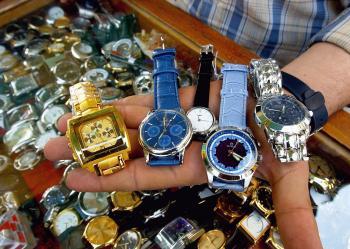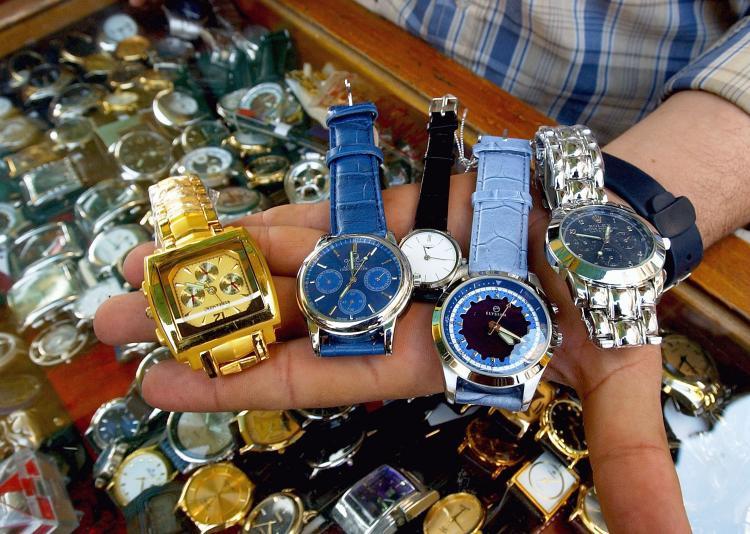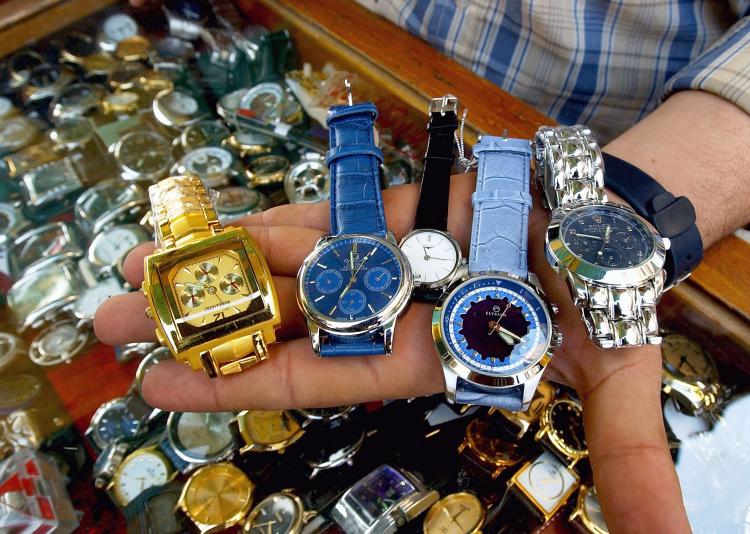Whether it’s counterfeit car parts, fake pharmaceuticals, pirated DVD movies, or cheap imitation designer purses, knock-off goods are becoming increasingly prevalent everywhere from flea markets and malls to direct-sales home parties and the internet.
Leaders from the business, legal, and academic communities and the RCMP are calling for stronger laws and resources to protect intellectual property (IP) rights in Canada.
They say counterfeiting and piracy are a growing problem that endangers people’s health and safety, funds organized crime, and stifles economic growth and innovation.
It might be tempting to pay $20 for multiple new or yet-to-be-released movies, or $40 for a bogus Louis Vuitton handbag as opposed to $800 for the real thing. But the public should know the risks and dangers of buying counterfeit and pirated products, said Sgt. Sylvain St-Jean, national intellectual property rights coordinator for the RCMP.
“The revenues usually go to organized crime,” he said. People buying these products could be funding drug and weapon trafficking, prostitution, or terrorism.
In addition, small, honest businesses selling authentic products at legitimate prices have a hard time competing and surviving, said Sgt. St-jean, adding that the RCMP investigates about 400 to 500 counterfeiting and piracy cases each year.
“If the public knew, for example, that many of the factories producing counterfeit products employ underage child labourers, or forced labourers, and use inferior materials that are very often unsafe, people might think twice before they buy anything that’s counterfeit,” said attorney Lorne Lipkus, who chairs the Canadian Anti-Counterfeiting Network’s (CACN’s) Education and Training Committee.
Examples of unsafe counterfeits include batteries that can explode, toothpaste contaminated with chemicals found in anti-freeze, and drug products that don’t contain the correct dosage of medicine.
A recent report by the Canadian Intellectual Property Council (CIPC), a coalition of companies supported by the Canadian Chamber of Commerce, said that weak domestic legislation “has allowed criminals to become rich from the proceeds gained from the sale of counterfeit goods, while at the same time the lack of regulation in the virtual world weakens the ability of industries to protect their intellectual property.”
Theft of intellectual property “pervades every industry. It’s not just luxury goods,” said CIPC’s director Chris Gray.
Everything from copyrighted music, software, video, and publications, to trademarked goods and services, to patented ideas and inventions can be stolen. Counterfeiters make huge profits, taking advantage of the design, marketing, and advertising paid for by the legitimate companies.
“Very often it’s an underground economy employing people who are paid through the black market, so even though these sales are taking place, no taxes are being paid.” Mr. Lipkus said.
The CIPC report notes that counterfeiting and piracy cost the Canadian economy an estimated $22 billion annually in lost tax revenue, investment, and innovation.
It’s a $600-billion worldwide problem facing global economies, according to the International Chamber of Commerce (ICC).
And these activities result in lost jobs.
“Especially in this uncertain economic climate, one of the things we need to do is hang onto knowledge-based jobs, and intellectual property rights is obviously very much linked to innovation and jobs,” Mr. Gray said.
Tom Corr, chief executive officer of the Accelerator Centre at University of Waterloo, agreed. The region of Waterloo has been very successful creating jobs in the high-technology sector.
“It’s very important for economic purposes that intellectual property is protected,” whether it is through patents, copyrights, trademarks, trade secrets, or other means, depending on the type of IP, he said.
“It’s really making sure that we can attract the entrepreneurs and investors to take the time and invest the money in the new technology that’s developed, knowing it will be protected.”
Last October the Paris-based ICC launched guidelines to help businesses protect their own IP-based products and services and to ensure they are not infringing other companies’ intellectual property rights (IPR).
Government has a big role, but “Canadian laws as they exist do not conform to the standards in the treaties that Canada has signed. They’re certainly not strong enough to really help stop counterfeiting and piracy,” said Mr. Lipkus.
In March 2007 the CACN documented the Canadian IPR system in detail and published a “Road Map for Change.” one of the first calls for change.
Two parliamentary committees that year unanimously adopted recommendations to improve IPR protection in Canada. Both in 2007 and 2008 the Throne Speech made similar commitments.
However, policy changes have been slow in coming, said the CIPC report.
In June 2007 Canada enacted Bill C-59, amending the Criminal Code to make it illegal to record a movie in a theatre without authorization.
The next new legislation, Bill C-61, was designed to implement the World Intellectual Property Organization’s (WIPO’s) Internet treaties that Canada signed in 1996, dealing with the growing problem of online piracy and counterfeiting worldwide.
However, the bill met with huge controversy and opposition, finally dying on the Order Paper when the Conservatives called an election last September and parliament was dissolved. It proposed amendments to the Copyright Act and critics charged that some of the new restrictions would open the door for consumers to face heavy fines and lawsuits.
The Conservative Party’s election platform pledged to reintroduce copyright legislation. But given the controversy around Bill C-61, observers expect that any new bill introduced will likely contain major amendments to the original version.
Nonetheless, the CIPC is urging the government to quickly adopt IP legislation that implements the WIPO Internet treaties and is consistent with international norms and standards, as well as clarifies some gray areas in existing IP laws.
The CIPC report also wants to see criminal legislation enacted that would make counterfeiting and piracy illegal under the Criminal Code, make trademark counterfeiting a criminal offence under the Trade-marks Act, and establish stronger penalties for counterfeiting and piracy that endanger health and safety.
In addition, the CIPC is calling for creation of an IPR Coordination Council to promote the development and commercialization of innovative products and services in Canada.
Canada also needs a specialized IP Crime Task Force to lead anti-counterfeiting and anti-piracy enforcement, and an IP education program targeting all Canadians, the report said.
Furthermore, a major issue to tackle is stopping counterfeit and pirated goods from entering Canada.
The CIPC wants the government to give the Canada Border Services Agency (CBSA) the necessary legal rights and resources to search specifically for counterfeit and pirated goods and to seize and destroy them, like the rights enjoyed by customs officials in the U.S. and elsewhere.
Currently CBSA officials have to call the RCMP to investigate if such a shipment is found.
But whether the RCMP will open an investigation depends on their availability and resources. Their priorities are counterfeit products with health and safety risks, those with links to organized crime, and large shipments.
The RCMP is “working with the private sector, other government agencies, and international partners to educate the public on [counterfeiting and piracy], hoping to provoke a change in their behaviour and attitude,” said Sgt. St-Jean.
To tell if a product is counterfeit, watch for things like shoddy appearance, spelling mistakes on the product or packaging, and prices very much lower than what you would expect for the brand name, according to posters produced by the RCMP and CACN.
“Even though it seems crimeless or victimless, it has a big impact on the community,” noted Sgt. St-Jean.
Leaders from the business, legal, and academic communities and the RCMP are calling for stronger laws and resources to protect intellectual property (IP) rights in Canada.
They say counterfeiting and piracy are a growing problem that endangers people’s health and safety, funds organized crime, and stifles economic growth and innovation.
It might be tempting to pay $20 for multiple new or yet-to-be-released movies, or $40 for a bogus Louis Vuitton handbag as opposed to $800 for the real thing. But the public should know the risks and dangers of buying counterfeit and pirated products, said Sgt. Sylvain St-Jean, national intellectual property rights coordinator for the RCMP.
“The revenues usually go to organized crime,” he said. People buying these products could be funding drug and weapon trafficking, prostitution, or terrorism.
In addition, small, honest businesses selling authentic products at legitimate prices have a hard time competing and surviving, said Sgt. St-jean, adding that the RCMP investigates about 400 to 500 counterfeiting and piracy cases each year.
“If the public knew, for example, that many of the factories producing counterfeit products employ underage child labourers, or forced labourers, and use inferior materials that are very often unsafe, people might think twice before they buy anything that’s counterfeit,” said attorney Lorne Lipkus, who chairs the Canadian Anti-Counterfeiting Network’s (CACN’s) Education and Training Committee.
Examples of unsafe counterfeits include batteries that can explode, toothpaste contaminated with chemicals found in anti-freeze, and drug products that don’t contain the correct dosage of medicine.
A recent report by the Canadian Intellectual Property Council (CIPC), a coalition of companies supported by the Canadian Chamber of Commerce, said that weak domestic legislation “has allowed criminals to become rich from the proceeds gained from the sale of counterfeit goods, while at the same time the lack of regulation in the virtual world weakens the ability of industries to protect their intellectual property.”
‘Pervades every industry’
Theft of intellectual property “pervades every industry. It’s not just luxury goods,” said CIPC’s director Chris Gray.
Everything from copyrighted music, software, video, and publications, to trademarked goods and services, to patented ideas and inventions can be stolen. Counterfeiters make huge profits, taking advantage of the design, marketing, and advertising paid for by the legitimate companies.
“Very often it’s an underground economy employing people who are paid through the black market, so even though these sales are taking place, no taxes are being paid.” Mr. Lipkus said.
The CIPC report notes that counterfeiting and piracy cost the Canadian economy an estimated $22 billion annually in lost tax revenue, investment, and innovation.
It’s a $600-billion worldwide problem facing global economies, according to the International Chamber of Commerce (ICC).
And these activities result in lost jobs.
“Especially in this uncertain economic climate, one of the things we need to do is hang onto knowledge-based jobs, and intellectual property rights is obviously very much linked to innovation and jobs,” Mr. Gray said.
Tom Corr, chief executive officer of the Accelerator Centre at University of Waterloo, agreed. The region of Waterloo has been very successful creating jobs in the high-technology sector.
“It’s very important for economic purposes that intellectual property is protected,” whether it is through patents, copyrights, trademarks, trade secrets, or other means, depending on the type of IP, he said.
“It’s really making sure that we can attract the entrepreneurs and investors to take the time and invest the money in the new technology that’s developed, knowing it will be protected.”
Calls for change
Last October the Paris-based ICC launched guidelines to help businesses protect their own IP-based products and services and to ensure they are not infringing other companies’ intellectual property rights (IPR).
Government has a big role, but “Canadian laws as they exist do not conform to the standards in the treaties that Canada has signed. They’re certainly not strong enough to really help stop counterfeiting and piracy,” said Mr. Lipkus.
In March 2007 the CACN documented the Canadian IPR system in detail and published a “Road Map for Change.” one of the first calls for change.
Two parliamentary committees that year unanimously adopted recommendations to improve IPR protection in Canada. Both in 2007 and 2008 the Throne Speech made similar commitments.
However, policy changes have been slow in coming, said the CIPC report.
In June 2007 Canada enacted Bill C-59, amending the Criminal Code to make it illegal to record a movie in a theatre without authorization.
The next new legislation, Bill C-61, was designed to implement the World Intellectual Property Organization’s (WIPO’s) Internet treaties that Canada signed in 1996, dealing with the growing problem of online piracy and counterfeiting worldwide.
However, the bill met with huge controversy and opposition, finally dying on the Order Paper when the Conservatives called an election last September and parliament was dissolved. It proposed amendments to the Copyright Act and critics charged that some of the new restrictions would open the door for consumers to face heavy fines and lawsuits.
The Conservative Party’s election platform pledged to reintroduce copyright legislation. But given the controversy around Bill C-61, observers expect that any new bill introduced will likely contain major amendments to the original version.
Nonetheless, the CIPC is urging the government to quickly adopt IP legislation that implements the WIPO Internet treaties and is consistent with international norms and standards, as well as clarifies some gray areas in existing IP laws.
The CIPC report also wants to see criminal legislation enacted that would make counterfeiting and piracy illegal under the Criminal Code, make trademark counterfeiting a criminal offence under the Trade-marks Act, and establish stronger penalties for counterfeiting and piracy that endanger health and safety.
Protecting the border, educating the public
In addition, the CIPC is calling for creation of an IPR Coordination Council to promote the development and commercialization of innovative products and services in Canada.
Canada also needs a specialized IP Crime Task Force to lead anti-counterfeiting and anti-piracy enforcement, and an IP education program targeting all Canadians, the report said.
Furthermore, a major issue to tackle is stopping counterfeit and pirated goods from entering Canada.
The CIPC wants the government to give the Canada Border Services Agency (CBSA) the necessary legal rights and resources to search specifically for counterfeit and pirated goods and to seize and destroy them, like the rights enjoyed by customs officials in the U.S. and elsewhere.
Currently CBSA officials have to call the RCMP to investigate if such a shipment is found.
But whether the RCMP will open an investigation depends on their availability and resources. Their priorities are counterfeit products with health and safety risks, those with links to organized crime, and large shipments.
The RCMP is “working with the private sector, other government agencies, and international partners to educate the public on [counterfeiting and piracy], hoping to provoke a change in their behaviour and attitude,” said Sgt. St-Jean.
To tell if a product is counterfeit, watch for things like shoddy appearance, spelling mistakes on the product or packaging, and prices very much lower than what you would expect for the brand name, according to posters produced by the RCMP and CACN.
“Even though it seems crimeless or victimless, it has a big impact on the community,” noted Sgt. St-Jean.







Friends Read Free